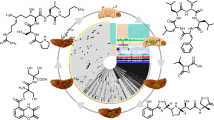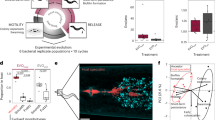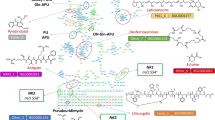Abstract
Photorhabdus and Xenorhabdus species have mutualistic associations with nematodes and an entomopathogenic stage1,2 in their life cycles. In both stages, numerous specialized metabolites are produced that have roles in symbiosis and virulence3,4. Although regulators have been implicated in the regulation of these specialized metabolites3,4, how small regulatory RNAs (sRNAs) are involved in this process is not clear. Here, we show that the Hfq-dependent sRNA, ArcZ, is required for specialized metabolite production in Photorhabdus and Xenorhabdus. We discovered that ArcZ directly base-pairs with the mRNA encoding HexA, which represses the expression of specialized metabolite gene clusters. In addition to specialized metabolite genes, we show that the ArcZ regulon affects approximately 15% of all transcripts in Photorhabdus and Xenorhabdus. Thus, the ArcZ sRNA is crucial for specialized metabolite production in Photorhabdus and Xenorhabdus species and could become a useful tool for metabolic engineering and identification of commercially relevant natural products.
This is a preview of subscription content, access via your institution
Access options
Access Nature and 54 other Nature Portfolio journals
Get Nature+, our best-value online-access subscription
$29.99 / 30 days
cancel any time
Subscribe to this journal
Receive 12 digital issues and online access to articles
$119.00 per year
only $9.92 per issue
Buy this article
- Purchase on Springer Link
- Instant access to full article PDF
Prices may be subject to local taxes which are calculated during checkout




Similar content being viewed by others
Data availability
All .mzXML files from the HPLC–MS/MS runs are available at MassIVE (https://massive.ucsd.edu) under the ID MSV000084163. Raw sequence data are available at the European nucleotide archive (https://www.ebi.ac.uk/ena/) under project accession numbers PRJEB33827 and PRJEB24159. The proteomic data can be accessed at PRIDE (https://www.ebi.ac.uk/pride/) with the project accession number PXD019095. Source data are provided with this paper.
References
Stock, S. P., Campbell, J. F. & Nadler, S. A. Phylogeny of Steinernema travassos, 1927 (Cephalobina: Steinernematidae) inferred from ribosomal DNA sequences and morphological characters. J. Parasitol. 87, 877–889 (2001).
Forst, S., Dowds, B., Boemare, N. & Stackebrandt, E. Xenorhabdus and Photorhabdus spp.: bugs that kill bugs. Annu. Rev. Microbiol. 51, 47–72 (1997).
Engel, Y., Windhorst, C., Lu, X., Goodrich-Blair, H. & Bode, H. B. The global regulators Lrp, LeuO, and HexA control secondary metabolism in entomopathogenic bacteria. Front. Microbiol. 8, 209 (2017).
Tobias, N. J. et al. Photorhabdus–nematode symbiosis is dependent on hfq-mediated regulation of secondary metabolites. Environ. Microbiol. 19, 119–129 (2017).
Santiago-Frangos, A. & Woodson, S. A. Hfq chaperone brings speed dating to bacterial sRNA. Wiley Interdiscip. Rev. RNA 9, e1475 (2018).
Holmqvist, E. & Vogel, J. RNA-binding proteins in bacteria. Nat. Rev. Microbiol. 16, 601–615 (2018).
Carrier, M.-C., Lalaouna, D. & Massé, E. Broadening the definition of bacterial small RNAs: characteristics and mechanisms of action. Annu. Rev. Microbiol. 72, 141–161 (2018).
Vogel, J. & Luisi, B. F. Hfq and its constellation of RNA. Nat. Rev. Microbiol. 9, 578–589 (2011).
Chao, Y., Papenfort, K., Reinhardt, R., Sharma, C. M. & Vogel, J. An atlas of Hfq-bound transcripts reveals 3′ UTRs as a genomic reservoir of regulatory small RNAs. EMBO J. 31, 4005–4019 (2012).
Papenfort, K. et al. Specific and pleiotropic patterns of mRNA regulation by ArcZ, a conserved, Hfq-dependent small RNA. Mol. Microbiol. 74, 139–158 (2009).
Mandin, P. & Gottesman, S. Integrating anaerobic/aerobic sensing and the general stress response through the ArcZ small RNA. EMBO J. 29, 3094–3107 (2010).
Chao, Y. et al. In vivo cleavage map illuminates the central role of RNase E in coding and non-coding RNA pathways. Mol. Cell 65, 39–51 (2017).
Beemelmanns, C., Guo, H., Rischer, M. & Poulsen, M. Natural products from microbes associated with insects. Beilstein J. Org. Chem. 12, 314–327 (2016).
Shi, Y.-M. & Bode, H. B. Chemical language and warfare of bacterial natural products in bacteria–nematode–insect interactions. Nat. Prod. Rep. 35, 309–335 (2018).
Brachmann, A. O. et al. Pyrones as bacterial signaling molecules. Nat. Chem. Biol. 9, 573–578 (2013).
Brameyer, S., Kresovic, D., Bode, H. B. & Heermann, R. Dialkylresorcinols as bacterial signaling molecules. Proc. Natl Acad. Sci. USA 112, 572–577 (2015).
Joyce, S. A. et al. Bacterial biosynthesis of a multipotent stilbene. Angew. Chem. Int. Ed. 47, 1942–1945 (2008).
Cai, X. et al. Entomopathogenic bacteria use multiple mechanisms for bioactive peptide library design. Nat. Chem. 9, 379–386 (2017).
Crawford, J. M., Portmann, C., Zhang, X., Roeffaers, M. B. J. & Clardy, J. Small molecule perimeter defense in entomopathogenic bacteria. Proc. Natl Acad. Sci. USA 109, 10821–10826 (2012).
Theodore, C. M., King, J. B., You, J. & Cichewicz, R. H. Production of cytotoxic glidobactins/luminmycins by Photorhabdus asymbiotica in liquid media and live crickets. J. Nat. Prod. 75, 2007–2011 (2012).
Lango-Scholey, L., Brachmann, A. O., Bode, H. B. & Clarke, D. J. The expression of stlA in Photorhabdus luminescens is controlled by nutrient limitation. PLoS ONE 8, e82152 (2013).
Kontnik, R., Crawford, J. M. & Clardy, J. Exploiting a global regulator for small molecule discovery in Photorhabdus luminescens. ACS Chem. Biol. 5, 659–665 (2010).
Wright, P. R. et al. CopraRNA and IntaRNA: predicting small RNA targets, networks and interaction domains. Nucleic Acids Res. 42, W119–W123 (2014).
Joyce, S. A. & Clarke, D. J. A hexA homologue from Photorhabdus regulates pathogenicity, symbiosis and phenotypic variation. Mol. Microbiol. 47, 1445–1457 (2003).
Bouvier, M., Sharma, C. M., Mika, F., Nierhaus, K. H. & Vogel, J. Small RNA binding to 5′ mRNA coding region inhibits translational initiation. Mol. Cell 32, 827–837 (2008).
Sharma, C. M., Darfeuille, F., Plantinga, T. H. & Vogel, J. A small RNA regulates multiple ABC transporter mRNAs by targeting C/A-rich elements inside and upstream of ribosome-binding sites. Genes Dev. 21, 2804–2817 (2007).
Yang, Q., Figueroa-Bossi, N. & Bossi, L. Translation enhancing ACA motifs and their silencing by a bacterial small regulatory RNA. PLoS Genet. 10, e1004026 (2014).
Wenger, R. H. Mammalian oxygen sensing, signalling and gene regulation. J. Exp. Biol. 203, 1253–1263 (2000).
Chen, J. J. & London, I. M. Regulation of protein synthesis by heme-regulated eIF-2α kinase. Trends Biochem. Sci. 20, 105–108 (1995).
Qi, Z., Hamza, I. & O’Brian, M. R. Heme is an effector molecule for iron-dependent degradation of the bacterial iron response regulator (Irr) protein. Proc. Natl Acad. Sci. USA 96, 13056–13061 (1999).
Rao, A. U., Carta, L. K., Lesuisse, E. & Hamza, I. Lack of heme synthesis in a free-living eukaryote. Proc. Natl Acad. Sci. USA 102, 4270–4275 (2005).
Bolla, R. Developmental nutrition of nematodes: the biochemical role of sterols, heme compounds, and lysosomal enzymes. J. Nematol. 11, 250–259 (1979).
Bode, E. et al. Promoter activation in Δhfq mutants as an efficient tool for specialized metabolite production enabling direct bioactivity testing. Angew. Chem. Int. Ed. 58, 18957–18963 (2019).
Zeng, Q., McNally, R. R. & Sundin, G. W. Global small RNA chaperone Hfq and regulatory small RNAs are important virulence regulators in Erwinia amylovora. J. Bacteriol. 195, 1706–1717 (2013).
Mukherjee, A., Cui, Y., Ma, W., Liu, Y. & Chatterjee, A. K. hexA of Erwinia carotovora ssp. carotovora strain Ecc71 negatively regulates production of RpoS and rsmB RNA, a global regulator of extracellular proteins, plant virulence and the quorum-sensing signal, N‐(3‐oxohexanoyl)‐l‐homoserine lactone. Environ. Microbiol. 2, 203–215 (2000).
Matilla, M. A., Leeper, F. J. & Salmond, G. P. C. Biosynthesis of the antifungal haterumalide, oocydin A, in Serratia, and its regulation by quorum sensing, RpoS and Hfq. Environ. Microbiol. 17, 2993–3008 (2015).
Wilf, N. M. & Salmond, G. P. C. The stationary phase sigma factor, RpoS, regulates the production of a carbapenem antibiotic, a bioactive prodigiosin and virulence in the enterobacterial pathogen Serratia sp. ATCC 39006. Microbiology 158, 648–658 (2012).
Wilf, N. M. et al. The RNA chaperone, Hfq, controls two luxR-type regulators and plays a key role in pathogenesis and production of antibiotics in Serratia sp. ATCC 39006. Environ. Microbiol. 13, 2649–2666 (2011).
Shanks, R. M. Q. et al. Suppressor analysis of eepR mutant defects reveals coordinate regulation of secondary metabolites and serralysin biosynthesis by EepR and HexS. Microbiology 163, 280–288 (2017).
White, G. F. A method for obtaining infective nematode larvae from cultures. Science 66, 302–303 (1927).
Goodman, A. L. et al. Identifying genetic determinants needed to establish a human gut symbiont in its habitat. Cell Host Microbe 6, 279–289 (2009).
Brachmann, A. O. et al. A type II polyketide synthase is responsible for anthraquinone biosynthesis in Photorhabdus luminescens. Chembiochem 8, 1721–1728 (2007).
Bankevich, A. et al. SPAdes: a new genome assembly algorithm and its applications to single-cell sequencing. J. Comput. Biol. 19, 455–477 (2012).
Seemann, T. Prokka: rapid prokaryotic genome annotation. Bioinformatics 30, 2068–2069 (2014).
Bolger, A. M., Lohse, M. & Usadel, B. Trimmomatic: a flexible trimmer for Illumina sequence data. Bioinformatics 30, 2114–2120 (2014).
Langmead, B. & Salzberg, S. L. Fast gapped-read alignment with Bowtie 2. Nat. Methods 9, 357–359 (2012).
Li, H. et al. The Sequence Alignment/Map format and SAMtools. Bioinformatics 25, 2078–2079 (2009).
Liao, Y., Smyth, G. K. & Shi, W. featureCounts: an efficient general purpose program for assigning sequence reads to genomic features. Bioinformatics 30, 923–930 (2014).
Fröhlich, K. S., Haneke, K., Papenfort, K. & Vogel, J. The target spectrum of SdsR small RNA in Salmonella. Nucleic Acids Res. 44, 10406–10422 (2016).
Gibson, D. G. Synthesis of DNA fragments in yeast by one-step assembly of overlapping oligonucleotides. Nucleic Acids Res. 37, 6984–6990 (2009).
Dunn, A. K., Millikan, D. S., Adin, D. M., Bose, J. L. & Stabb, E. V. New rfp- and pES213-derived tools for analyzing symbiotic Vibrio fischeri reveal patterns of infection and lux expression in situ. Appl. Environ. Microbiol. 72, 802–810 (2006).
Corcoran, C. P. et al. Superfolder GFP reporters validate diverse new mRNA targets of the classic porin regulator, MicF RNA. Mol. Microbiol. 84, 428–445 (2012).
Tobias, N. J., Linck, A. & Bode, H. B. Natural product diversification mediated by alternative transcriptional starting. Angew. Chem. Int. Ed. 57, 5699–5702 (2018).
Hilker, R. et al. ReadXplorer 2-detailed read mapping analysis and visualization from one single source. Bioinformatics 32, 3702–3708 (2016).
Smith, C., Heyne, S., Richter, A. S., Will, S. & Backofen, R. Freiburg RNA Tools: a web server integrating INTARNA, EXPARNA and LOCARNA. Nucleic Acids Res. 38, W373–W377 (2010).
Hakobyan, A., Liesack, W. & Glatter, T. Crude-MS strategy for in-depth proteome analysis of the methane-oxidizing Methylocystis sp. strain SC2. J. Proteome Res. 17, 3086–3103 (2018).
Glatter, T. et al. Large-scale quantitative assessment of different in-solution protein digestion protocols reveals superior cleavage efficiency of tandem Lys-C/trypsin proteolysis over trypsin digestion. J. Proteome Res. 11, 5145–5156 (2012).
Tobias, N. J. et al. Cyclo(tetrahydroxybutyrate) production is sufficient to distinguish between Xenorhabdus and Photorhabdus isolates in Thailand. Environ. Microbiol. 121, 2921–2932 (2019).
Acknowledgements
This work was funded in part by the DFG (SFB 902, project no. B17) and the LOEWE Centre for Translational Biodiversity Genomics (LOEWE TBG), supported by the State of Hesse. K.P. acknowledges funding by the DFG (EXC 2051, grant no. 390713860), Vallee Foundation and European Research Council (grant no. StG-758212). We thank A. Goodman for providing pSAM-BT and for helpful discussions. We thank L. Pöschel and A. K. Heinrich for the plasmid construction.
Author information
Authors and Affiliations
Contributions
N.N., N.J.T., M.H., X.C., A.L.L., T.G. and S.J.P. performed the experiments, except sequencing of the transposon-insertion mutants, which was performed by S.J.P. and T.P.S. N.N., N.J.T., M.H., K.P. and H.B.B. designed the study, discussed the results and commented on the manuscript. N.N., N.J.T. and M.H. analysed and interpreted the data. N.N., N.J.T. and M.H. wrote the manuscript. All of the authors read and approved the final manuscript.
Corresponding author
Ethics declarations
Competing interests
The authors declare no competing interests.
Additional information
Publisher’s note Springer Nature remains neutral with regard to jurisdictional claims in published maps and institutional affiliations.
Extended data
Extended Data Fig. 1 Northern blot analysis of various sRNAs in P. laumondii.
Expression of various sRNAs in P. laumondii at different time points. RNA samples of P. laumondii WT and ∆hfq strains were taken at three different OD600 values (0.5, 2 and 4) and after 24 h of growth. The RNA was loaded on northern blots and probed for the indicated sRNAs. Probing for 5 S rRNA served as loading control.
Extended Data Fig. 2 Northern blot analysis of various sRNAs in X. szentirmaii.
Expression of various sRNAs in X. szentirmaii at different time points. RNA samples of X. szentirmaii WT and ∆hfq strains were taken at three different OD600 values (0.5, 2 and 4) and after 24 h of growth. The RNA was loaded on northern blots and probed for the indicated sRNAs. Probing for 5 S rRNA served as loading control.
Extended Data Fig. 3 Phenotype and specialized metabolite profile of transposon-insertion mutants of P. laumondii.
Phenotype of transposon-insertion mutants of P. laumondii. a. Differences in pigmentation of transposon-insertion mutant liquid cultures compared to WT. Depicted are eleven transposon-insertion mutants and a WT culture after 3 d of cultivation at 30 °C with shaking. b. SM profiles of the transposon-insertion mutants. Relative SM production was quantified from duplicates using TargetAnalysis (Bruker) and compared to the WT of P. laumondii after 72 h cultivation at 30 °C with shaking. Mutant 3 was analysed further and the transposon insertion was identified in the arcZ gene.
Extended Data Fig. 4 Nematode bioassay.
Infective juvenile development to hermaphrodites with strains of P. laumondii and X. szentirmaii. Data are presented as the mean ± s.e.m. Dots represent biologically independent replicates (n = 10). Asterisks indicate statistical significance (*P < 0.05, **P < 0.005, ***P < 0.0005, ****P < 0.00005) of relative recovery compared to WT recovery levels. Statistical significances were calculated using a two-sided unpaired t-test. Exact p values (left to right, respectively) for P. laumondii TTO1 correspond to p = <0.0001, 0.0006 and for X. szentirmaii to P = 0.56, 0.0094.
Supplementary information
Supplementary Information
Supplementary Figs. 1–5 and Supplementary Notes.
Supplementary Tables
Supplementary Tables 1–18.
Source data
Source Data Fig. 2a
Unprocessed northern blots.
Source Data Fig. 2c–h
Raw data of specialized metabolite quantification using TargetAnalysis.
Source Data Fig. 3b,e
Raw data of the GFP measurements (b) and specialized metabolite quantification with TargetAnalysis (e).
Source Data Fig. 3c,d
Unprocessed northern blots.
Source Data Extended Data Fig. 1
Unprocessed northern blots.
Source Data Extended Data Fig. 2
Unprocessed northern blots.
Source Data Extended Data Fig. 4
Raw data of nematode bioassays.
Rights and permissions
About this article
Cite this article
Neubacher, N., Tobias, N.J., Huber, M. et al. Symbiosis, virulence and natural-product biosynthesis in entomopathogenic bacteria are regulated by a small RNA. Nat Microbiol 5, 1481–1489 (2020). https://doi.org/10.1038/s41564-020-00797-5
Received:
Accepted:
Published:
Issue Date:
DOI: https://doi.org/10.1038/s41564-020-00797-5
This article is cited by
-
Enhancement of herbicolin A production by integrated fermentation optimization and strain engineering in Pantoea agglomerans ZJU23
Microbial Cell Factories (2023)
-
In vivo RNA interactome profiling reveals 3’UTR-processed small RNA targeting a central regulatory hub
Nature Communications (2023)
-
High-throughput sequencing analysis reveals genomic similarity in phenotypic heterogeneous Photorhabdus luminescens cell populations
Annals of Microbiology (2022)
-
Global analysis of biosynthetic gene clusters reveals conserved and unique natural products in entomopathogenic nematode-symbiotic bacteria
Nature Chemistry (2022)
-
Two novel XRE-like transcriptional regulators control phenotypic heterogeneity in Photorhabdus luminescens cell populations
BMC Microbiology (2021)



